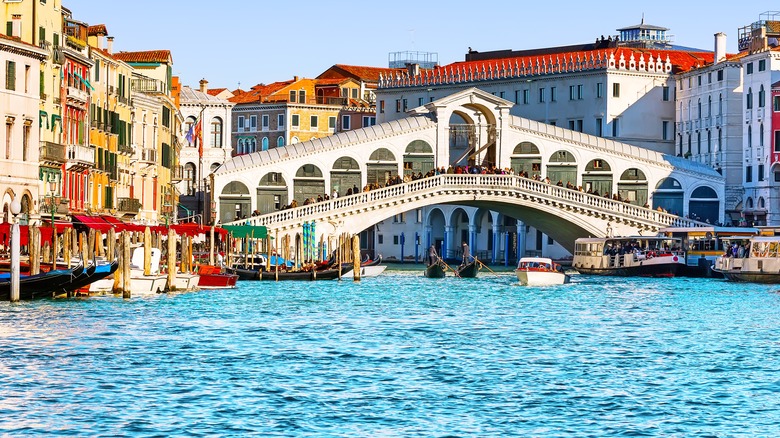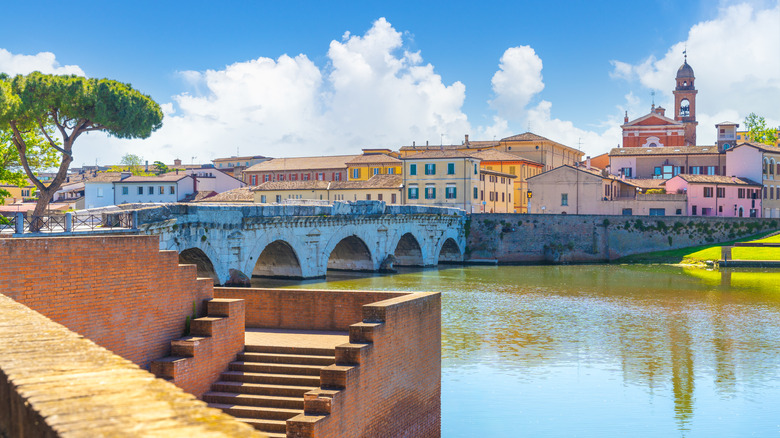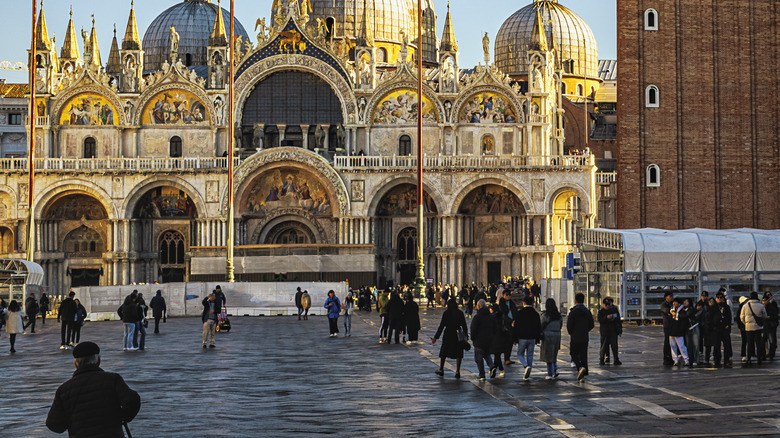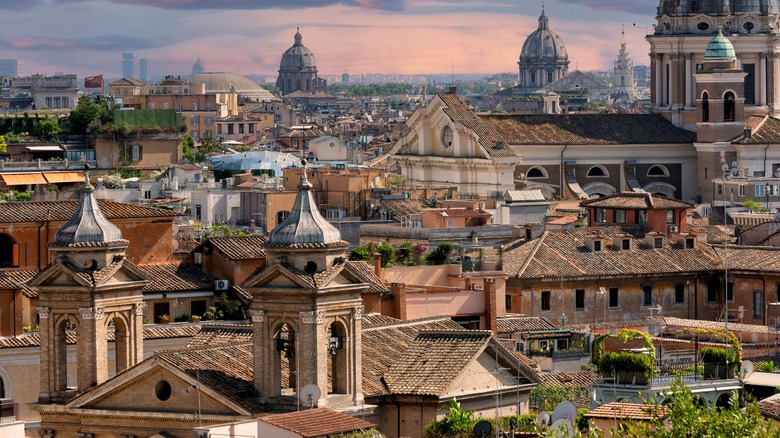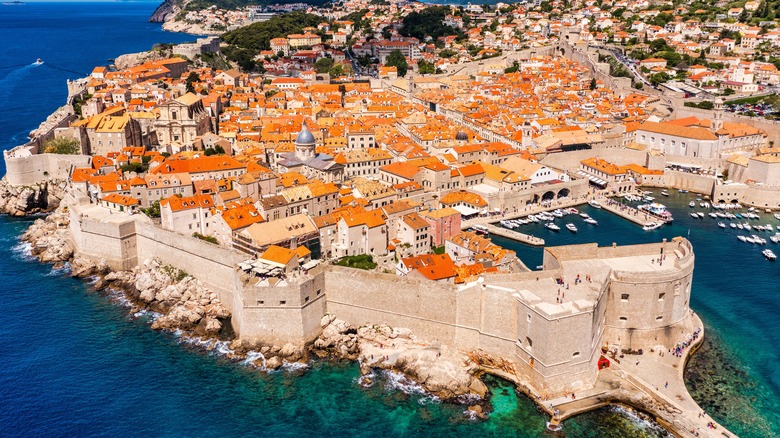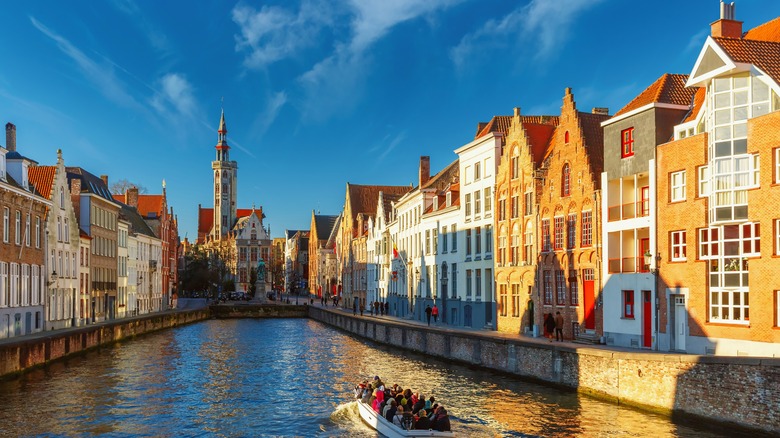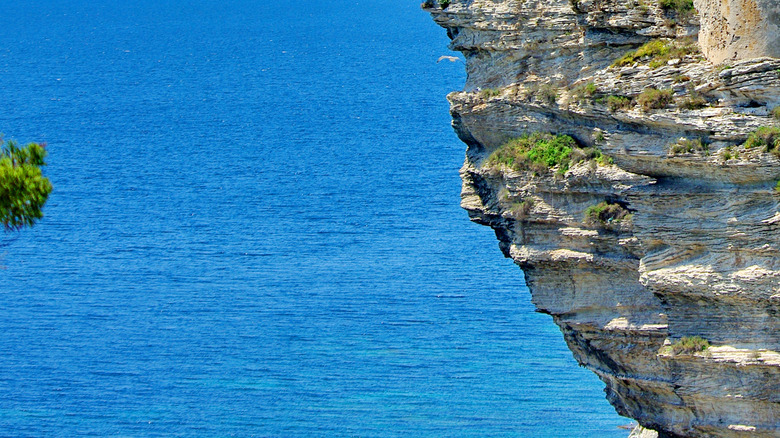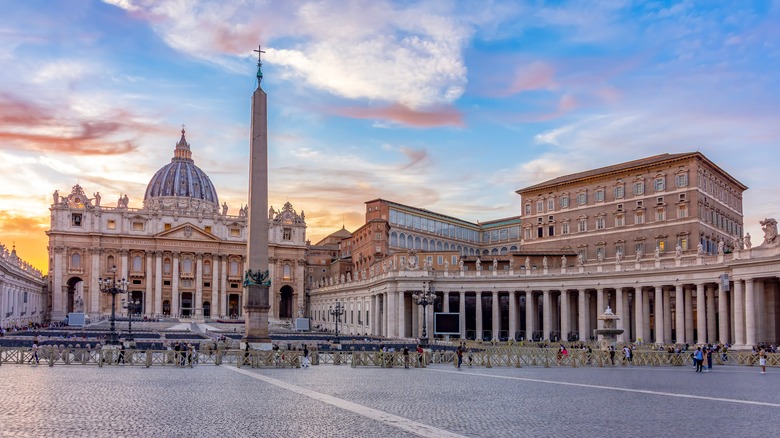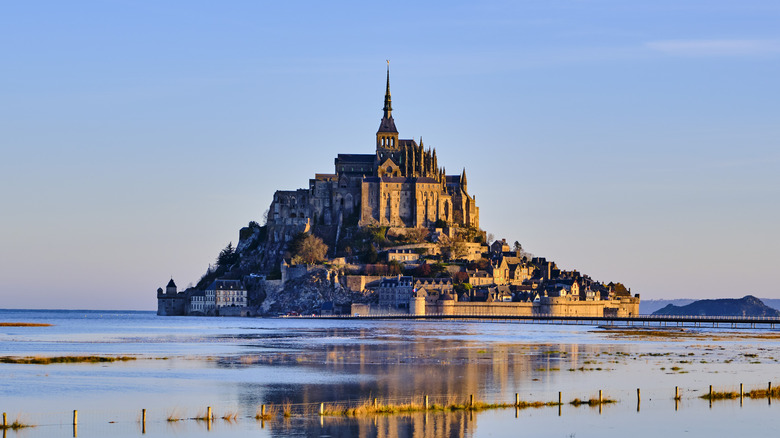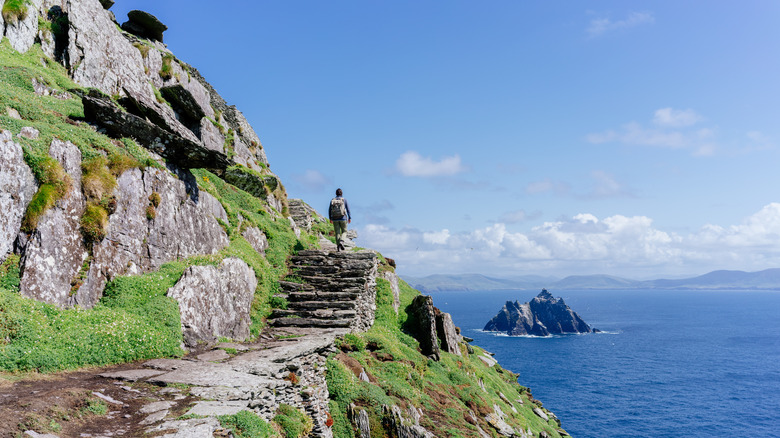The Most 'Overtouristed' Places In Europe
According to the EU's Eurostat, 2024 was a year for the record books, as tourists spent a combined 1.2 billion nights in the Old Continent soaking up its sights and history. Great news for these countries' coffers, not so much for locals facing more tourists than their cities can handle.
Anyone who visits Europe's major attractions will notice that it's really crowded. Unsurprising since these are gorgeous places. But they are also victims of their success — everyone wants to be there, turning them from living, breathing cities into open-air museums. Local small businesses and cultural institutions meant for the inhabitants are nowhere to be found. This takes away from the whole point of tourism — to experience new cultures and meet the people to whom they belong. Readers might notice that smaller places not on par with the big cities like Rome and Amsterdam face these problems and more — think literal destruction or cultural and environmental degradation from tourism's homogenizing effects.
But Europe is jam-packed with hidden gems where local cultures survive and thrive. If you know where to look and are ready to sacrifice the trendy destinations, not only will you get to experience the country and its people beyond the homogenized glitz and glamor of tourist traps — but your wallet will probably thank you as well.
Rimini
Chances are most Americans are not familiar with Rimini — Adriatic party-city central for young Italians and wealthy Russians. In fact, when it comes to the number of tourists per square kilometer, Rimini was Italy's No. 1 most crowded, "overtouristed" destination, according to a study from Italian statistics firm Demoskopika (via Finestre sull'Arte). The town has nearly 43 tourists per resident, barely nudging out Venice, the highest number of tourism accommodations (a proxy for overcrowding). Also, it leads Italy in terms of tourist waste production, being the center of a papal-endorsed project to clean up marine litter, much of it left by tourists. Unlike other parts of Italy, however, Rimini's overtourism problems are mostly local, as 80% of visitors are Italians.
Rimini is hardly unique in Italy. It's a beach destination and a party place and Italy has tons of both. For the beach, the southern region of Puglia (Italy's heel) is a much cheaper and lesser-known destination (at least compared to the big guns like Venice and Rome). It boasts fantastic food (especially olive oil), beaches, and even sulfur springs, which do wonders for the skin, in places such as Santa Cesarea Terme. And they are in the middle of the Adriatic — no need to check into a spa, although you can do that too. Follow that with a three-course restaurant dinner at less than 25 euros a person. If you want to party, hit up the town of Gallipoli.
Venice
Once the center of Europe's most powerful mercantile state, Venice now counts a mere 50,000 inhabitants, who face 20 million tourists yearly. Venetian travel agency Venezia Autentica crunched the numbers. Each year, approximately 600 cruise ships pollute the air and the Venetian Lagoon, causing environmental damage to one of the area's most unique ecosystems. On the ground, Venice's eight square kilometers are not built to handle millions. The city's population peaked at 174,000 in 1951. Between cruise ships carrying 10,000 passengers each and millions more who fly in, combined with locals unable to afford the city they have inhabited for centuries, proud Venetians' uneasiness with seeing their once-glorious home become part of an exhibit in an open-air museum is understandable.
It's hard to pass up Venice since it's one of a kind, but if one wants to avoid summer crowds, there are alternatives. Istria, the heart-shaped Croatian peninsula was once part of Venice's empire and preserves that legacy in its language, food, and architecture. Find the remaining local Italians and you are likely to get a far more authentic Venetian cultural experience than in Venice's tourist traps. Within Italy, there is the Habsburg gem of Trieste. The city, on the Slovenian border, boasts Austrian, Italian, Hungarian, and Slovene influences, and is just two hours east by car. You may not get the Grand Canal or St. Mark's Square, but instead, you can enjoy an aperitivo on the Piazza Unità d'Italia.
Rome
The Eternal City doesn't seem at first horribly overtouristed, with 7 million tourists in 2023 against a population of about 3 million (per Statista). Compared to places like Barcelona, this is nothing. But since most of the tourism is concentrated in the city center, locals have felt the bite mostly on the economic and quality of life fronts.
Rome's tourist problems include loitering around the Trevi Fountain, fighting over selfie spots, long lines, and more. Romans have seen their central neighborhoods' small businesses decimated by mafia-owned souvenir shops run by trafficked migrants selling counterfeit goods to tourists. Finally, there is disrespectful tourist behavior in churches, ranging from inappropriate dress to disrupting masses, committing sacrilege by receiving communion as non-Catholics, and even taking consecrated hosts as souvenirs. The city is considering an entry fee to the area around the Trevi Fountain while the Italian government has begun cracking down on souvenir shops and illegal street vendors.
To be honest, there are no alternatives to Rome — it's called the Eternal City for a reason. But there are ways to avoid the overtourism problem. For instance, if the Coliseum is too crowded, opt for the forums or the Palatine, which are a bit less crowded. Ditto for St. Peter's — the papal basilica of Santa Maria Maggiore is a gorgeous alternative. Regarding food, tourists looking to avoid crushes should look for restaurants and cafes ordinary Romans frequent. They are often cheaper and provide an authentic Roman culinary experience compared to the homogenized restaurants catering to mass tourism.
Dubrovnik
The Croatian pearl of the Adriatic consistently ranks in the top five most overtouristed destinations, according to Total Croatia. With attractions like the Palazzo Sponza, the Rector's palace, the city walls, the Cathedral of St. Blaise, and the "Game of Thrones" tour, it's hard to blame the 2.2 million tourists who visit the city of around 40,000 inhabitants.
While overtourism brings short-term economic benefits, the long-term effects are devastating for locals. The historical center is pretty much dead, with only 1,557 inhabitants according to The Dubrovnik Times as of 2019. Multiple business owners and artists told Adventure.com that tourism has pushed local businesses and artists — the very things that give a place its charm — to the port suburb of Gravosa. Businesses catering to mass tourism have moved in, creating a homogenized tourist culture that attracts dollars but does not reflect the city's character.
A good alternative to Dubrovnik, according to English travel writer Andrew Eames (via iNews), is the Montenegrin city of Kotor. The former Venetian gem that mass tourism hasn't quite discovered yet resembles Dubrovnik in that both are fortified Adriatic cities that are UNESCO World Heritage sites (although Kotor is on a bay). However, instead of a cathedral to St. Blaise, you get one to St. Tryphon; there are a lot more cats; and it is a quieter, cheaper experience walking through the labyrinthine streets. And if Kotor isn't enough, the picturesque Italian-Slavic Venetian towns of Risan, Perasto, and many more are a hop and a skip away across the bay.
Barcelona
From La Sagrada Familia Cathedral to the Picasso Museum and a thriving dining and nightlife scene, the Catalan capital is a magnet for everyone from art and culture connoisseurs to those who just want to party. The city set a new overtourism record in 2023-2024, when the approximately 1.6 million inhabitants received 32 million tourists. These unsustainable numbers, which demand more short-term rentals and tourist-centric businesses, have created a housing shortage and price spikes in the city center. Businesses like grocery stores and pharmacies have been priced out, leaving locals without essential services. Catholics — foreign and domestic — wishing to worship at churches like La Sagrada Familia have to compete with secular tourists and go through metal detectors just to use the church for its intended purpose.
If one wants to stay in Catalonia, Girona and Tarragona — smaller cities with their own churches and Roman ruins — provide a calmer experience. But if you really want something new, go west to the Asturian capital of Oviedo in northern Spain — it has something for everyone. This UNESCO World Heritage site is famous for its cathedrals, museums, parks, and apple cider — a local delicacy. It is close to the mountain sanctuary of Covadonga, the "cradle of Spain," and the Picos de Europa National Park. So if you're sick of crowds and just want to walk on a clear day alongside cows grazing in mountain pastures against a backdrop of snow-capped peaks — but you still want to get your art and architecture fix — give this lesser-known part of Spain a chance.
Bruges
The Belgian city of Bruges is known as the "Venice of the North," but if you thought this city of 120,000 was La Serenissima without the crowds or the price tag, think again. The city that Euronews described as having "postcard-perfect scenery" deals with 8.3 million tourists yearly, who come to see the medieval center and its canals. The city's reaction would be amusing if overcrowding and the collapse of non-tourist-related businesses in the city center weren't noxious to the city's future survival as a living, breathing place.
The town has gone beyond the usual measures of cruise restrictions and entry fees — it has even pulled advertisements from places like the Brussels airport in an attempt to prevent tourists from even finding out it exists. The cat is out of the bag now, so it's probably too late for that, but Bruges isn't the only nice place in Belgium if one wants medieval. Within Belgium, iNews' Saskia O'Donoghue recommends the city of Ghent instead. History buffs get a medieval town with a large fortress, churches, and cobbled streets. Culture buffs get a thriving art scene that is not catered exclusively to the homogenous world of mass tourism. And for those who want a good time, it was voted Europe's youth capital in 2024, in no small part thanks to the university there that creates a vibrant nightlife scene that the City of Ghent is quite proud of.
Corsica
The island of Corsica has managed to stay off mass tourism's radar due to its image as a mafia stronghold, but lately, its coastal real estate, beaches, and unspoiled mountains have become a draw. However, development has brought 3 million yearly tourists, crowds, and concrete to the island of 300,000 which threatens its culture and ecosystem.
In response, Corisca has capped visitors to 2,000 daily at the most visited natural parks to limit environmental damage, per Connexion France. But no such measures are possible on the cultural front. An analysis by the Adrian Leeds Real Estate Group in the U.K. found that the island is gaining 5,000 non-Corsican residents (mostly from France) per year who buy second homes and price out locals. Ethnic Corsicans (about 50% of the population) fear their culture and language, a close relative of Italian, will be demographically swamped in favor of French and homogenized mass tourism, a reasonable fear considering the language is already endangered.
Tourists who want nature without crowds, tourist caps, or the powder keg that is Corsican ethnolinguistic politics should check out the necropolis of Pantalica in southwestern Sicily — a gorge that gives alternating hot and cold a new meaning. Hikers enter the gorge in the burning summer heat through a 3,000-year-old necropolis whose tombs are cut into the cliffs. At the bottom of the gorge is a forest through which runs a cool river that you can swim and refresh yourself in. Once you're done, go enjoy a delicious Sicilian lunch in one of the nearby towns.
Vatican City
In 2019, Religion News Service asked a Vatican tour guide what her job was like. She responded in one word: hell. Not exactly a description one would expect for the center of the Catholic Church, but given this tiny, 109-acre state received 7 million visitors in 2023-2024 (5-6 million before COVID), the guide's sentiment is understandable. After all, it technically only accommodates 20,000 people at most — the Renaissance papal court.
Visitors to the Vatican face crowds, protestors, Roman summer heat, long security lines to St. Peter's Basilica, and limited tickets for the Vatican Museums. Add tourist tantrums over being denied entrance over improper dress, arguments over line-cutting, and lack of respect from some towards the church, and it can become a frustrating experience, especially for those with small children or who are there to pray.
If one is willing to postpone it or skip the Vatican (a tough choice, especially for Catholics), the city of Rome is full of gorgeous Renaissance and Baroque churches. Two of the most impressive are the basilicas of Santa Maria Maggiore and Santa Maria degli Angeli, whose central location allow tourists to avoid crowds by opening at 7 a.m. and closing at 7 p.m. (8 a.m. for the latter). Apart from those two, look around. You can find artistic masterpieces in literally any random church in Rome and you never know which hidden gem you might discover next!
Mont-Saint Michel
The Norman island fortress-cum-abbey has a permanent population of 25 monks and nuns plus support staff, who must manage 3 million tourists per year. France 24 crunched the numbers for 2022, finding that this came out to about 36,000 tourists per day during the high season in a town of only 1.5 square miles, whose population has never exceeded 1,200. Unsurprisingly, one reviewer commented on TripAdvisor that it was a "crowded tourist trap" because the streets are not wide enough to handle the summer rush.
The abbey's measures to alleviate overcrowding might have worsened the problem. The town banned motor vehicles from driving up to the abbey. Instead, the only way to get there is to walk or take a shuttle. Now imagine the crowds when everyone is trying to get to and from the place at the busiest hours — according to reviews, we're talking a line of 500 or more people waiting for a 20-person horse-drawn shuttle. For the abbey, there is no winning here. It needs tourism, but at the same time, allowing too much threatens to degrade what makes the place so unique.
Like Italy, France is full of beautiful churches that aren't so crowded. Lonely Planet recommends the Solesmes Abbey, a large Gregorian community overlooking the Loire. Otherwise, if religious tourism is your thing, head south because you won't want to miss St. Mary Magdalene's body, which lies in the basilica in Saint-Maximin-la-Sainte-Baume in Provence. Take a look and then enjoy the land of rosé wine and lavender.
Skellig Michael
This island's former monastery off Ireland's west coast poses a special conundrum to tourism authorities. When "Star Wars: The Last Jedi" and "The Force Awakens" were filmed there, it became a hit destination, kind of like Dubrovnik with "Game of Thrones," but on a smaller scale. An Irish Times report found the monastery was risking falling apart from the 16,000 yearly tourists who frequented it — not a huge number, but a problem when one realizes the monastery is built using the dry stone method — stones stacked on each other with no mortar. It could handle a few monks, not thousands of people tramping through it. The Irish government has sought to limit environmental damage with strict visitor caps. Visits are capped at 180 per day, to be booked months in advance through a government-licensed boat operator.
If you can't make it to Skellig Michael, you're in luck. Irish posters on Tripadvisor recommend the Blasket Islands, Ballinskelligs Bay, St. Senan's Church on Scattery Island, or the Island of Ishmurray, which according to posters, is a little secret they would prefer the world not discover. Scattery has also seen tourist numbers decline recently, which means there are fewer crowds and it's quieter to enjoy what one happy tourist called "a lovely spot – beautiful and spiritual" — a sentiment most others shared.
